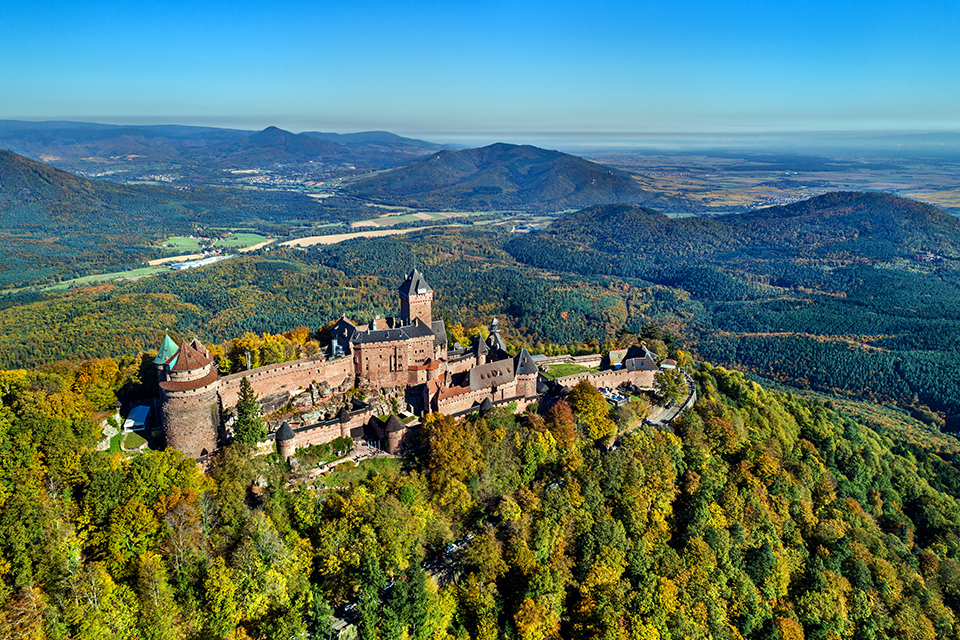Château du Haut-Kœnigsbourg is one of the the most thrilling experiences in the Middle Vosges in Alasace
In the heart of the Alsace region of France, perched majestically atop a rugged hill in the Vosges, stands the formidable Château du Haut-Kœnigsbourg. This iconic medieval fortress, with its storied past and architectural grandeur, embodies the region’s rich history and cultural heritage. With a history of over eight centuries, the castle has witnessed countless tales of conquest, rivalry, and resilience, making it a symbol of Alsace’s enduring spirit.
A Glimpse into History: Origins and Early Years

The origins of Château du Haut-Kœnigsbourg trace back to the 12th century when the castle was constructed by the Hohenstaufen dynasty under the reign of Frederick I, also known as Frederick Barbarossa. First mentioned in 1147, the location of the castle at the top of the “Stophanberch” may have given name to this dynasty. The castle was situated strategically along the medieval trade routes between France and Germany. As such, the castle with nine other castles served as a crucial stronghold, commanding control over the surrounding lands, offering protection to its inhabitants and propitious possibilities for extracting tributes and taxes from the villages below. In 1238, the Hohenstaufen dynasty lost the castle, and in 1246 the Bishops at Strassbourg possessed the overlordship.
Over the centuries, the castle exchanged hands multiple times, witnessing periods of prosperity and turmoil. In the 15th century, the castle fell under the possession of the Habsburg family, marking the beginning of its transformation into a formidable fortress. Under the Habsburg rule, extensive renovations were undertaken, fortifying the castle’s defences and expanding its architectural footprint.
Renaissance and Resurgence: Château du Haut-Kœnigsbourg in the Modern Era

By the 17th century, Château du Haut-Kœnigsbourg had evolved into a grand Renaissance-style residence, reflecting the architectural tastes of the time. However, with the onset of the Thirty Years’ War and subsequent conflicts, the castle fell into a state of disrepair, its once-glorious halls echoing with the whispers of bygone eras.
It wasn’t until the late 19th century that Château du Haut-Kœnigsbourg experienced a remarkable resurgence, thanks to the efforts of Emperor Wilhelm II of Germany (Der Kaiser). Recognizing the castle’s historical significance and architectural splendour, Wilhelm II initiated an ambitious restoration project to return the fortress to its former glory. Under the guidance of renowned architect Bodo Ebhardt, the castle underwent extensive renovations, blending elements of medieval and Renaissance architecture to create a harmonious tapestry of styles. The completion of the decoration and interior took place between 1908-1914. After the first World War, however, the French confiscated the castle in accordance with the Treaty of Versailles.
At 757 metres high, the castle lies at the top of the “Stophanberch” and dominates the Plain of Alsace. Today, visitors to Château du Haut-Kœnigsbourg are greeted with a captivating journey through the annals of history as they traverse its ancient ramparts, winding staircases, and imposing towers. The castle’s architectural marvels, from its imposing keep to its intricately carved stone facades, offer a glimpse into the craftsmanship and ingenuity of medieval builders.
Beyond the gate and the portcullis lies the lower courtyard. One of the highlights of a visit to the castle is the Grand Salon, also called the Kaiser’s room, a lavish hall adorned with ornate tapestries, antique furniture, and exquisite artworks, evoking the grandeur of Renaissance-era court life as the German emperor envisaged this life at the end of the 19th century. As visitors wander through the castle’s labyrinthine corridors and chambers, they are transported back in time, immersing themselves in the rich tapestry of Medieval and Renaissance life.
From the commanding vantage points of the castle’s towers, visitors are treated to breathtaking panoramic views of the Alsace countryside, with its rolling vineyards, picturesque villages, and verdant forests stretching as far as the eye can see. It is a reminder of the strategic significance of the castle’s location and its role as a sentinel guarding the borders of the Alsace region.
Preserving the Legacy: Conservation and Heritage

In recent years, efforts to preserve and safeguard the legacy of Château du Haut-Kœnigsbourg have been undertaken, ensuring that future generations can continue to marvel at its timeless beauty. Conservation initiatives, guided by a commitment to historical authenticity and cultural stewardship, have helped maintain the castle’s structural integrity and protect it from the ravages of time and nature. A Medieval garden is one of the new sights added in the last twenty years.
Moreover, the castle serves as a vibrant cultural hub, hosting various events, exhibitions, and educational programs to foster an appreciation for Alsace’s rich heritage. From medieval reenactments to guided tours and educational workshops, Château du Haut-Kœnigsbourg continues to inspire and captivate visitors, inviting them to embark on a journey through the annals of history.
As the sun sets behind the rugged hills of the Alsace region, casting a golden glow upon the ancient stones of Château du Haut-Kœnigsbourg, one cannot help but be filled with a sense of awe and wonder. For centuries, this magnificent fortress has stood as a testament to the will to dominate the surrounding countryside and collect customs from merchants and pilgrims moving across the frontiers between Germany and France.
In the shadow of its towering ramparts, Château du Haut-Kœnigsbourg continues to cast its spell upon all who behold its splendour, reminding us of the enduring power of the past to shape the present and illuminate the path forward. Indeed, it is a treasure to be cherished and preserved for generations to come, a living testament to the timeless allure of medieval mystique and the indomitable spirit of Alsace.
SOURCE:
Der Burgenbau der Staufer im Elsass
By Thomas Biller and Bernhard Metz
In: Burg und Kirche der Stauferzeit
Regensburg 2002, pp 76 – 110
READ MORE:
